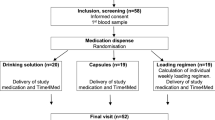Abstract
We aimed to assess the safety and efficacy of high-dose intermittent vitamin D supplementation in adolescents. Twenty-two healthy adolescents with serum 25 hydroxy-vitamin D (25-OHD) of 12.5–50 nmol/l were randomised to receive 300 000 IU or 150 000 IU of vitamin D3, or placebo orally 6-monthly for 1 year. At 12 months, the average vitamin D levels for the 300 000 IU, 150 000 IU and placebo groups were 63.0, 41.1 and 35.8 nmol/l, respectively, (P=0.004 for difference between 300 000 IU group and placebo after adjustment for age, sex and seasonal variation). At 12 months, one participant receiving 300 000 IU was mildly deficient (25-OHD 49 nmol/l), whereas five out of six (83%) in the placebo and four out of seven participants (57%) in the 150 000 IU group remained deficient. There were no adverse events. Compliance was high. This suggests that 300 000 IU vitamin D3 orally 6-monthly may safely and effectively correct vitamin D deficiency in adolescents.
This is a preview of subscription content, access via your institution
Access options
Subscribe to this journal
Receive 12 print issues and online access
$259.00 per year
only $21.58 per issue
Buy this article
- Purchase on Springer Link
- Instant access to full article PDF
Prices may be subject to local taxes which are calculated during checkout


Similar content being viewed by others
References
Cheng S, Tylavsky F, Kroger H, Karkkainen M, Lyytikainen A, Koistinen A et al. (2003). Association of low 25-hydroxyvitamin D concentrations with elevated parathyroid hormone concentrations and low cortical bone density in early pubertal and prepubertal Finnish girls. Am J Clin Nutr 78, 485–492.
Dwyer T, Blizzard L, Gies PH, Ashbolt R, Roy C. (1996). Assessment of habitual sun exposure in adolescents via questionnaire--a comparison with objective measurement using polysulphone badges. Melanoma Res 6, 231–239.
Jones G, Dwyer T, Hynes KL, Parameswaran V, Greenaway TM. (2005). Vitamin D insufficiency in adolescent males in Southern Tasmania: prevalence, determinants, and relationship to bone turnover markers. Osteoporos Int 16, 636–641.
Lehtonen-Veromaa MK, Mottonen TT, Nuotio IO, Irjala KM, Leino AE, Viikari JS. (2002). Vitamin D and attainment of peak bone mass among peripubertal Finnish girls: a 3-y prospective study. Am J Clin Nutr 76, 1446–1453.
Looker AC, Dawson-Hughes B, Calvo MS, Gunter EW, Sahyoun NR. (2002). Serum 25-hydroxyvitamin D status of adolescents and adults in two seasonal subpopulations from NHANES III. Bone 30, 771–777.
Orrell-Valente JK, Jarlsberg LG, Hill LG, Cabana MD. (2008). At what age do children start taking daily asthma medicines on their own? Pediatrics 122, e1186–e1192.
Outila TA, Karkkainen MU, Lamberg-Allardt CJ. (2001). Vitamin D status affects serum parathyroid hormone concentrations during winter in female adolescents: associations with forearm bone mineral density. Am J Clin Nutr 74, 206–210.
Vieth R. (1999). Vitamin D supplementation, 25-hydroxyvitamin D concentrations, and safety. Am J Clin Nutr 69, 842–856.
Winnick S, Lucas DO, Hartman AL, Toll D. (2005). How do you improve compliance? Pediatrics 115, e718–e724.
Winzenberg T, Powell S, Shaw KA, Jones G. (2011). Effects of vitamin D supplementation on bone density in healthy children: systematic review and meta-analysis. BMJ 342, c7254.
Winzenberg TM, Powell S, Shaw KA, Jones G. (2010). Vitamin D supplementation for improving bone mineral density in children. Cochrane Database Syst Rev (10): CD006944. doi:10.1002/14651858.CD006944.pub2.
Acknowledgements
This study was funded by the Royal Hobart Hospital Research Foundation. GJ and TW received National Health and Medical Research Council Funding through a Practitioner Fellowship and a General Practice Training Fellowship, respectively.
Author information
Authors and Affiliations
Corresponding author
Ethics declarations
Competing interests
The authors declare no conflict of interest.
Rights and permissions
About this article
Cite this article
Carnes, J., Quinn, S., Nelson, M. et al. Intermittent high-dose vitamin D corrects vitamin D deficiency in adolescents: a pilot study. Eur J Clin Nutr 66, 530–532 (2012). https://doi.org/10.1038/ejcn.2011.204
Received:
Revised:
Accepted:
Published:
Issue Date:
DOI: https://doi.org/10.1038/ejcn.2011.204
Keywords
This article is cited by
-
Vitamin D in pediatric age: consensus of the Italian Pediatric Society and the Italian Society of Preventive and Social Pediatrics, jointly with the Italian Federation of Pediatricians
Italian Journal of Pediatrics (2018)
-
The optimal dosage regimen of vitamin D supplementation for correcting deficiency in adolescents: a pilot randomized controlled trial
European Journal of Clinical Nutrition (2018)
-
Vitamin D and Bone Health in Childhood and Adolescence
Calcified Tissue International (2013)
-
Is high-dose cholecalciferol justified in children with chronic kidney disease who failed low-dose maintenance therapy?
Pediatric Nephrology (2013)


